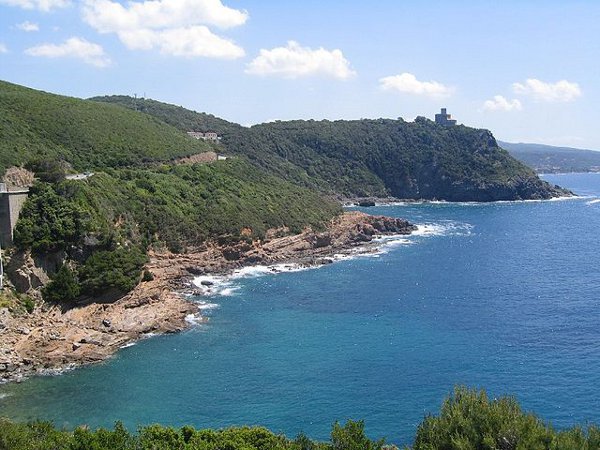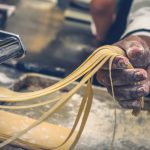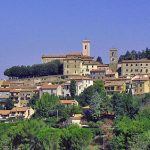From the origins to the Medici.
The first historical evidence relating to Licorno dates from the ninth century, when the settlement was nothing more than a fraction of the Port Pisano.Il Its development began in the late thirteenth century, when, with the statutes of Pisa in 1284, it was determined that the captain the port had to live in Livorno.Gli same statutes, in order to populate the harbor village, They arranged for special customs facilities and privileges to all those who, within the next ten years, they decided to establish his residence and activities Livorno.Ma August 1284 Pisa and Livorno were attacked by the Genoese and Lucca, which arrecarono a lot of damage to the towers and castle Livorno.Siglata peace in 1299, began the reconstruction period, which culminated with the fortification of the port of Livorno. Inextricably bound to Pisa, Livorno suffered the same sorti.In following the killing of Peter Gambacorta in 1392, lord of Pisa from 1370, the city and its port passed for several years under the rule of the Duke of Milan Gian Galeazzo Visconti. Pisa was able to rebel against the dominion of the Visconti in 1405, but the following year it had to surrender to a new enemy: Firenze.Livorno in the meantime had passed under the government of Genoa, which lasted until 1421, when the Genoese decided to consent to repeated request of Florence to buy Livorno.Il Doge Tommaso Fregoso, being in need of money to defend the Republic of Genoa from the Milanese, revenges Livorno to Florence in June 1421 for 100,000 gold florins. To purchase the Florentine Republic Livorno meant to have a port of its own for those international trade for which Florence had long famosa.Esattamente as he had done in 1284, Pisa, Florence also decided to facilitate the population of Livorno.Molti Florentine artisans settled there to build galleys desired by the republic for the transport of goods.
1200 florins a year were allocated for the construction of a jail every six mesi.La Republic also decided to keep in Livorno a series of tax breaks to allow the development of the port city which later silting of the port of Pisa soon became the first port of call is the Toscana.Ma with the ascent to power of the Medici that the history of Livorno lived a real svolta.Già the beginning of the sixteenth century, Cardinal Giulio de ‘Medici, then ascended to the papal throne in 1523 with the the name of Pope Clement VII, commanded by Antonio da Sangallo the Elder design for a fortress difensiva.Non are certain the dates of construction of what is now called the Old Fort, according to some historical fact, the defensive building was erected between 1521 and 1524, while according to others the work continued until after the 1530.E ‘instead sure Sangallo fortress incorporated into some existing structures like the tower of Matilde and the “quadrature of Pisa.”
Livorno under the Grand Duchy of Tuscany.
The first Grand Duke of Tuscany, Cosimo I, in 1548 issued a law with which was granted to any person who decides to settle in Livorno, the cancellation of any debt incurred in precedenza.La law meant that by the mid-sixteenth century Livorno began to learn about the phenomenon of immigration destined to become more and more consistent with the laws of the 1593.Cosimo I also ordered Giorgio Vasari, a project for the construction of the new pier, and in the meantime he thought to further fortify the city continued to grow in importance . Once dead Cosimo I, his son Francis, he continued the work, addressing the architect Bernardo Buontalenti for the design of a new Livorno, a sort of fortress city with the Cathedral at its March 28, 1577 centro.Il the same Francis I , during a solemn ceremony, laid the foundation stone of the new walls of the Medici Grand Duke Livorno.Il that more than others, however, tied its name from the city of Livorno was Ferdinand I, brother of Francis I and came to power in 1587. It was in fact ordered to Realize the project Buontalenti. Livorno therefore became a city with strong walls surrounded by a waterway, full of palaces, warehouses, barracks and other dogane.Un waterway joined Livorno Pisa.Ma what most of all contributed to the rapid development of the port city was the publication. June 10 of 1593, the famous “read Livornine” in favor of the merchants of every place and every religione.In practice it was a real indulgence with which he favored the
Population of the city, giving political asylum to all those who wished to settle in Livorno and open up a business. Law favored especially the Jews, who landed in the Tuscan port a bit ‘from all countries Europei.Nel 1606, three years before death, Ferdinand I wished to crown his work by raising the honor of Livorno city.The son of Ferdinand, Cosimo II, found itself to administer a city flourishing, full of artisans and merchants, where they crossed races and cultures very different between loro.Livorno, in the seventeenth century, was a rare example of coexistence among many peoples and at the end of 1700 had already become the second largest city in Tuscany with 80,000 inhabitants (Florence had 100,000). Under Cosimo II was made the Medici Port, and the city was declared a free port.
Livorno today.
With Cosimo II closes the period of maximum development of Livorno, which however continued to thrive seeing their commerci.Nessuno of the Grand Dukes later took it to the city customs privileges that had allowed the rapid evolution. With the annexation of the Grand Duchy of Tuscany to the Kingdom of Italy, Livorno underwent a new development, no longer linked only to the commercial port, but also to some industrial activities connected to it.
To shipyards slowly joined by other industrial activities (chemical, petrochemical, engineering, conservation of fish) that have now made Livorno a modern and very attivo.Anche tourist activity emerged in the late nineteenth century, transforming a station in Livorno much sought after and renowned seaside resort at the start of our secolo.La city experienced an important cultural season, inspired by writers such as
Marranos, and painters like Modigliani Factors and musicians such as Pietro Mascagni, all of birth Livorno.
The Second World War caused much damage to Livorno, who also knew how to recover through rapidità.Oggi the city has more than 170,000 inhabitants, and the province, which stretches all along the coastline, includes 20 Comuni.Ben five of the seven islands that make up the ‘archipelago toscan0 are also in the province of Livorno: Gorgona, Capraia, Elba, Montecristo and Pianosa.
ART
Churches and palaces
The center of the ancient city designed by Buontalenti represented by Piazza Grande, which overlooks the cathedral dedicated to Saint Francis, and built between 1594 and 1606 and designed by Alessandro Pieroni.Il cathedral was later expanded during the bombing 1700.I World War II earned him considerable damage to the Cathedral of Livorno, which was then rebuilt along the lines originali.L ‘interior has a Latin cross with a single nave, and there are precious works, such as the Assumption of Passignano and St. Francis receiving Child of Mary Empoli. To the right of the entrance you can admire the monument to the Marquis Marco Alessandro del Borro, the work of the Florentine artist Giovan Battista Foggini.Piazza Grande was completely rebuilt after the Second World War, and therefore the buildings surrounding it are all impression moderna.Dietro to the Grand Palace, which is located in front of the Duomo, opens wide the Town Hall with the Town Hall built in 1720 and designed by John Fantasia.All the ‘interior of the building it has a fine painting of Sustermans, which portrays the Grand Duke Ferdinand II in the act of receiving the mercanti.Imboccando Via S. John arrives at the church of the same name originally from the thirteenth century and enlarged in 1624.Non far from the church of St. John the Baptist is the temple dedicated to Santa Caterina, which is also an eighteenth century work of John of fantasy within the coronation of the Virgin of Giorgio Vasari.Ancora to oggini must instead the design of the church of San Ferdinando, also called the spreader, built between 1707 and 1714.Senza doubt it is one of the most interesting churches in the city with beautiful works of Giovanni Baratta all ‘ interno.All ‘corner between the Piazza Grande and Guerazzi is the palace of the call a beautiful building built in 1707 for use militari.Non far it meets the Costernino, ie the building where it was regulated water distribution. The Costernino is the work of neoclassical structure designed by Pasquale Poccianti in 1842.Pochi years before, between 1829 and 1832, the same Poccianti had achieved Cisternone, ie the reservoir of the aqueduct. Near the Cisternone is the Palazzo De Larderei school, built in neoclassical style in the well 18321850, industrialist De Larderei.
Just south of Livorno is the Shrine of Our Lady of Montenero, built in the sixteenth century on a hill instead of a pre-existing oratorio.Secondo to legend, in 1345, an image of the Virgin Mary came from the island Ardenza Eubea.L ‘ image was brought by some hermits on the hill and enclosed within a oratorio.Ben soon the fame of the miracles of Our Lady of Montenero spread along the Tyrrhenian coast, and the shrine became a place of pellegrinaggi.Alle walls of the sacristy are many votive testifying the cult that has grown over the centuries around the Madonna di Montenero.
The city Medici
The heart of the ancient city is the Cathedral, built by Bernardo Buontalenti at the center of the pentagon wall that surrounded the Livorno Rinascimento.Il the Royal Canal marks the ancient town in the south, while to the north-west and north-east are respectively the Old Fortress and the Fortress Nuova.Voluta by Duke Alessandro de ‘Medici the Old Fortress was designed by Antonio da Sangallo.I works for the construction of the fortress began in 1531 and lasted until 1537.La fort has a perimeter wall of 500 three meters bastioni.Su one of the two portals of entry is the coat of arms of the Duke instead Alessandro.La New Fortress was built in 1590, under the Grand Duke Ferdinando I, the design of Giovanni de ‘Medici, Vincenzo Bernardo Bonanni and Buontalenti.In Originally, the two forts were linked by a curtain that was torn down during the seventeenth century to make room for new neighborhoods of Venice and San Marco, the most characteristic città.Immediatamente south of the Old Fortress opens the Medici Port, with the old dock, Fortino’s Sassaia and Molo Mediceo.Da latter reach the Tower of the light, erected the first time in the sixteenth century and destroyed during the War mondiale.La tower was rebuilt in 1955 according to the guidelines originarie.Alla its base are the remains of the hospital built by Francis I in 1582.
On the eastern side of the Old Dock-open piazza Giuseppe Micheli.E ‘here that was erected in 1607 what later became the sculpture symbol of Livorno: the Monument to Ferdinand I, also known as the Four Mori.Si is a statue the Grand Duke in the uniform of the Knights of Santo Stefano sculpted by Giovanni Bandini and placed on a plinth around which there are four Moors in chains, to be cast by Pietro Tacca and added to the monument at a later tempo.I four Turkish slaves were merged with cannons taken from the Arabs and the Turks won by the soldiers of the Grand Duchy during the daring expedition in 1607 by Ferdinand I really wanted to conquer the city of Hippo.
I Macchiaioli and museum Giovanni Fattori.
Around the middle of last century, Florence was formed the most important and constructive work of the Italian artistic movement, that of Macchiaioli.La school macchiaioli was born in opposition and contrast academicism that had characterized the first half of the century with its “Historical paintings.” The theory was the basis of this artistic movement was that of the “spot”, which chronologically precedes the French impressionism and that in some respects there avvicina.I macchiaioli believed that the painter had to make exactly what the human eye perceives, ie colored patches of light and ombra.Il more representative of the movement of macchiaioli was the painter Giovanni Fattori, born in Livorno in 1825.E right in the most important exponent of the “stain” Livorno titled a museo.Il Civic Museum Giovanni Fattori located in the park of Villa Fabbricotti, in a building ottocentesca.Il museum houses a collection of paintings of factors including “Haystack, Oxen, Antignano, On the Beach, Red Tower, Lutteri Battle of San Martino, Mrs. Martelli, Portrait of the Wife. ” The Museum possesses some ancient works such as the Madonna and Child attributed to Sandro Botticelli and the Crucifixion of Blacks by Bicci.
Museo Civico Giovanni Fattori
Villa Mimbelli
Via San Jacopo in Acquaviva
Phone 0586.808001 – 804847
The important collection of paintings by Giovanni Fattori and other Macchiaioli and post macchiaioli stored at Livorno – that was the birthplace of factors – has received a rational arrangement and a worthy place in the prestigious Villa Mimbelli.
In the beautiful rooms of the Villa, built in 1865 by architect Giuseppe Micheli and recently restored, the civic collection ‘was rearranged according to a precise criteriostorico artistic and enriched by a new group of interesting works hitherto preserved in deposits.
Overall we were able to have on the three floors of the works so far villacecentotrentasei depositi.Oltre preserved in the paintings of factors, which are the most ‘valuable riccae of the collection, the new Museum offers the public the chance and aglistudiosi’ to appreciate famous and important operedi painters, such as, Silvestro Lega, Caesar and John Bartolena, the Tommasi, Vittorio Corcos, Michele Gordigiani, Leonetto Cappiello and others, that have characterized the artistic events italianea horse between eight hundred and nine hundred
http://tuscanysea.com/backoffice/immagini/tuscanysea.com/23-17-5-2013-11-18-561.jpg
http://tuscanysea.com/backoffice/immagini/tuscanysea.com/23-17-5-2013-11-18-562.jpg



